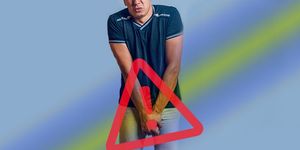Not being able to pee can be a pretty uncomfortable condition, whether you really feel like you have to, or whether you think it’s about time you should pee. Thankfully, there are solutions. We talked to a urologist about what to do when you need to go but you just can’t, and a few reasons behind the problem.
There are a few reasons you can’t pee:
You’re dehydrated
If your bladder’s relatively empty and it’s been a while since you peed, chances are you’re a little bit dehydrated. No worries, a few glasses of water can fix that.
Enlarged or inflamed prostate
Typically seen in older men, an enlarged prostate can make you unable to pee, says Jed Kaminetsky, MD, a urologist at NYU Langone Health, as its location underneath the bladder can obstruct it if enlarged. Another possibility is prostatitis, an infection of the prostate that causes it to be inflamed or swell. Sexually transmitted infections like chlamydia, gonorrhea, and occasionally herpes have the ability to inhibit urination by causing the prostate to swell, he says.

Pelvic trauma
Any kind of trauma to the urethra (a punch, a kick, etc.), according to Dr. Kaminetsky, can also create a blockage, leading to the inability to urinate.
Certain drugs
According to Dr. Kaminetsky, some drugs like ketamine, cocaine, and even certain prescription medications have the ability to inhibit urination. Some studies, like this one in BMJ Case Reports, suggest that frequent ketamine use can even cause irreversible damage to the urinary system. Yikes.
Urinary obstruction
Anything from a urinary tract infection to ureter stones can create a blockage in the urinary tract, making it difficult or even impossible to pee. If you feel the urge to pee after drinking plenty of water, but nothing is coming out, it’s definitely time to see a doctor.
Shy bladder syndrome
Some people just can’t pee at public toilets, a psychosocial issue casually called “shy bladder syndrome,” and it affects roughly 21 million American men—who may hold it until it gets really uncomfortable.
How to make yourself pee
Drink water
If you can’t pee due to dehydration, the natural thing to do would be to rehydrate and drink water, says Dr. Kaminetsky. Some signs of severe dehydration include dark yellow pee to not being able to pee at all after several hours, lightheadedness, nausea, and even fainting. “If you’re [severely] dehydrated, your blood pressure could drop, you could pass out, or develop kidney failure,” says Dr. Kaminetsky.
Sit in a tub of warm water
“The first thing I tell someone who feels like they have to pee but they can’t is to sit in a hot tub of water,” says Dr. Kaminetsky “That relaxes the pelvic floor muscles.” He recommends this method only if you feel the uncomfortable urge to pee, but for some reason you can’t. And yes, it’s okay to release in the water if you have to, but ideally you get to the toilet before you have to.
If all else fails, see a doctor
Since being unable to pee can be pretty dangerous, seeing a doctor is crucial if home remedies aren’t working, especially if it’s been more than 36 hours since you’ve urinated. “The first thing I would do is do an ultrasound of the bladder,” sats Dr. Kaminetsky. “That would tell me if the bladder is full or if it’s empty and you only have the sensation of having to pee.” If your bladder’s empty, your doc would suggest you drink some fluids. If not, they may have to insert a catheter to drain the bladder and figure out the underlying cause. And if the problem is related to your prostate, your doctor can prescribe medicine that can help.
Source: Read Full Article

